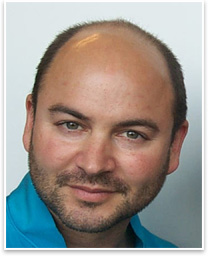 The Power of Diversity The Power of Diversity
Craig Dykers, AIA
Summary: “They say you can’t make great design by committee. But you can, and you should. Buildings are used by many people, and many people should have input into how they are created.”—Craig Dykers
At the 2009 AIA Convention in San Francisco, Craig Dykers, AIA, will join other international architects and Pulitzer Prize-winning journalist John Hockenberry in delivering the Friday morning plenary session, Focus on Practice in a Complex World. He talked with AIArchitect about his work and the upcoming presentation in San Francisco.
Dykers is a principal designer and co-founder of Snøhetta, the acclaimed multi-disciplinary design firm based in Oslo, Norway, and New York City. Snøhetta was formed in 1989 primarily to prepare a design competition proposal for the Alexandria Library in Egypt. The firm won the competition, and the library received the Aga Khan Award for Architecture in 2004.
Design philosophy
Our company is focused on bringing disciplines together, some that are collaborative but aren’t often together in one studio. We’re 15 percent landscape architects, and in all of our projects we try to work with landscape architects from the beginning of the conceptual process. That’s one idea that’s very important.
Another is that we’re quite collaborative and the studio really acts as a drawing studio in the traditional sense. We work as a team and allow viewpoints and ideas to be heard. It doesn’t matter your age or experience. If the idea is strong enough and people rally around it, the project can move forward.
Finally, we’re culturally diverse. We’re equally male and female and we try to keep a strong social condition in the office.
Benefit from the presentation
I believe the historical methods of architectural practice are slowly changing and the notion of a star architect or master of a studio in which people are hired to carry out their vision will slowly disappear. There’s nothing inherently wrong with that, but it makes it difficult to react to the wide range of social issues that we face today. Populations are better educated and more in tune with the architectural environment than in the past, so designs can no longer be the sole domain of an individual, no matter how talented that person may be. In our practice, we’re trying to develop a socially conscious design process that would react directly to a socially conscious populace.
Diversity
The way we’ve developed our office and approach to projects represents an understanding of the need for diversity. Are we a Norwegian office, a Norwegian-international office? It’s difficult to say. Certainly, we have our roots in various places, but we’re not limited to the political boundaries of a country. In that sense, it’s more like scientists might see their work as unlimited, not held back by political boundaries.
We try to build diversity by bringing in different people and stabilizing the office environment. We pay our staff well. Our staff is internally unionized, so they negotiate salaries and build the office together. There’s no behind-the-scenes wheeling and dealing. Everybody’s salaries are published, and we all have a similar work environment. The principals sit at a desk just like everybody else in the room. I think trying to remove some of the hierarchy in the design environment allows for more diversity.
Vision of the profession in 5-10 years
Five years ago, I would’ve said my fear is that there will be only five architecture companies in the world, and each will employ 250,000 people. There was that direction in all things, not just architecture. People now realize that it’s not self-sustaining. As they say, the bigger they are the harder they fall. Maintaining wide variety in company and practice types is becoming understandable. The current financial condition shows that in industries like finance and automobile manufacturing, when two or three fall, they all fall. If there were 15 to 20 smaller companies, it might be easier to keep some of them alive in difficult conditions. If we’re very fortunate, we may see the continued strength of smaller, lesser known companies able to practice a wider range of projects.
Best practice tip
Respecting your staff means respecting your profession. What I would like architects to do better is respect not only ourselves, but the people who work for us.
|


